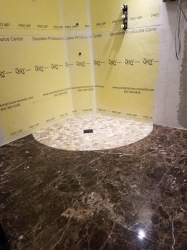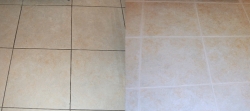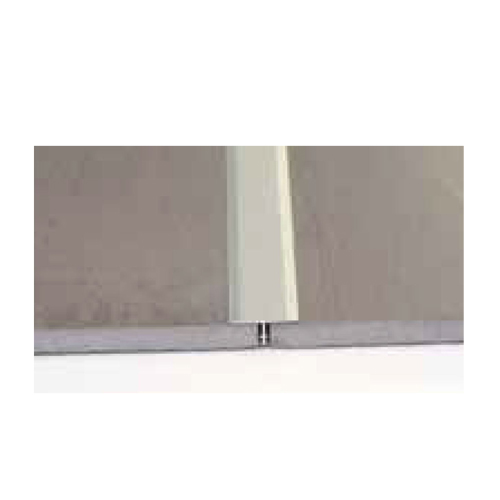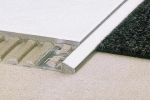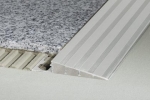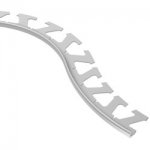Schluter RENO-T Floor Transition Profiles

Schluter RENO-T Floor Transition Profiles
- Designed to provide transitions between existing same-height, hard-surface floor coverings.
- 2.5 m (8' 2-1/2") Length; 9 mm (11/32") Height
- Available in Stainless Steel, Solid Brass, Aluminum, and Anodized Aluminum.
Consider an alternative product
Schluter RENO-T Floor Transition Profiles
Application and Function

Schluter-RENO-T is designed to provide transitions between existing same-height, hard-surface floor coverings (e.g., ceramic tile or natural stone, parquet flooring, concrete pavers, laminate, etc.), primarily in retrofit applications.
The profile is available in stainless steel, solid brass, and anodized aluminum. Schluter-RENO-T is installed within the existing joint cavity and overlaps adjoining surface materials, thus preventing edges from becoming damaged when subjected to mechanical stress.
RENO-T, in brass and anodized aluminum size 9/14, is flexible in the lateral direction and can be used in curved applications.
Available Sizes and Materials
W = top width Stainless steel 304 (1.4301 = V2A) (E) Brushed stainless steel 304 (1.4301 = V2A) (E) Solid brass (M) Satin anodized aluminum (AE) Satin nickel anodized aluminum (AT) Satin copper/bronze anodized aluminum (AK) Satin brass anodized aluminum
(AM)14 mm - 17/32" T9/14E T9/14EB T9/14M T9/14AE T9/14AT T9/14AK T9/14AM 25 mm - 1" T9/25E T9/25EB T9/25M T9/25AE T9/25AT T9/25AK T9/25AM Installation
Schluter RENO-T Installation
- Select Schluter-RENO-T according to joint width, to ensure proper support of the lateral crosspiece.
- The joint cavity must be at least 3/8" (9 mm) deep and free of debris. Substances that inhibit adhesion must be removed from the sides of the joint.
- Fill the joint with elastomeric sealant such as Schluter-KERDI-FIX or similar. Then insert the vertical leg of Schluter-RENO-T in the joint so that the lateral crosspiece rests completely on the edges of the surface coverings.
- Remove any excess sealant with a suitable cleaner.
Material
Schluter-RENO-T is available in stainless steel, solid brass, and anodized aluminum.
In special cases, the suitability of a proposed type of material must be verified based on the anticipated chemical, mechanical, and/or other stresses.
Schluter-RENO-T, in stainless steel, is rollformed using 304 (1.4301 = V2A) stainless steel. Therefore, the profiles contour differs slightly from those made of extruded brass or aluminum. The profile can sustain high mechanical stresses and is especially well suited for applications requiring resistance against chemicals and acids; for example, in the food industry, breweries, dairies, commercial kitchens, public swimming pools, and hospitals.
Schluter-RENO-T, in solid brass, is capable of withstanding high mechanical stresses and is resistant to most chemicals encountered in tiled environments. Solid brass that is exposed to air will oxidize, resulting in a natural patina. If exposed to moisture or aggressive substances, heavy oxidation and spotting may occur.
Schluter-RENO-T, in anodized aluminum, must be tested to verify its suitability if chemical exposure is expected. Cementitious materials, in conjunction with moisture, become alkaline. Since aluminum is sensitive to alkaline substances, exposure to the alkali (depending on the concentration and duration of exposure) may result in corrosion (aluminum hydroxide formation). Therefore, it is important to remove mortar or grout residue from visible surfaces. In addition, ensure that the profile is solidly embedded in the setting material and that all cavities are filled to prevent the collection of alkaline water. The anodized surface layer retains a uniform appearance during normal use, but must be protected against abrasion.
Maintenance
Schluter-RENO-T requires no special maintenance or care and is resistant to mold and fungi. Clean profile using common household cleaning agents.
Stainless steel surfaces exposed to the environment or aggressive substances should be cleaned periodically using a mild household cleaner. Regular cleaning maintains the neat appearance of stainless steel and reduces the risk of corrosion. All cleaning agents must be free of hydrochloric and hydrofluoric acid. Stainless steel surfaces develop a sheen when treated with a chrome-polishing agent.
Oxidation films on exposed solid brass can be removed by using a conventional polishing agent, but will form again.
In the case of anodized aluminum, do not use abrasive cleaning agents. Damage to the anodized layer can be repaired by applying varnish.
Customer Reviews and Ratings
No reviews yet! Be the first to review this product.
Product Shipping Information
You will be able to estimate shipping amount to your specific destination for your entire cart during the checkout process.
General shipping InformationKeywords: schluter, reno, profile, floor, edge, protection, decoration, transition, finishing, tile, carpet, stairs, steel, stainless, aluminum, solid, brass, anodized, satin, chrome, nickel, copper, bronze, bright, flooring trim - underlayment, tile edge profiles, edge protection and transition, schluter systems, Schluter, Floor, Transition, Profiles, Designed, provide, transitions, between, existing, height, surface, coverings, Length, Height, Available, Stainless, Steel, Solid, Brass, Aluminum, Anodized
Description: Schluter RENO-T Floor Transition Profiles. Designed to provide transitions between existing same-height, hard-surface floor coverings. 2.5 m (8' 2-1/2") Length; 9 mm (11/32") Height. Available in Stainless Steel, Solid Brass, Aluminum, and Anodized Aluminum.
Categories: Tile Edge Profiles > Edge Protection and Transition
Google Category: Hardware > Flooring
SKU(s): 153474, 153475, 153476, 153477, 153478, 153479, 153480, 153481, 153482, 153483, 153484, 153485, 153486, 153487
MPN(s): T9/14AE, T9/14AK, T9/14AM, T9/14AT, T9/14E, T9/14EB, T9/14M, T9/25AE, T9/25AK, T9/25AM, T9/25AT, T9/25E, T9/25EB, T9/25M

